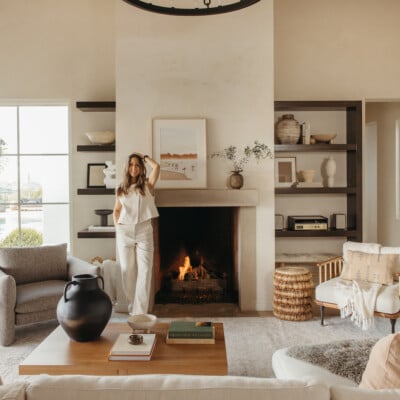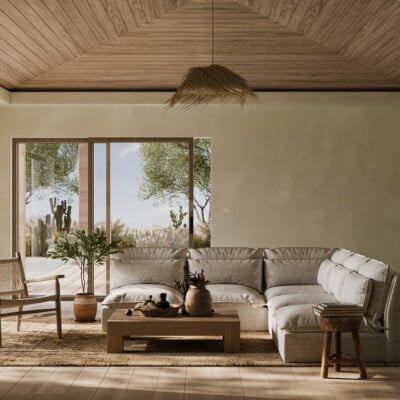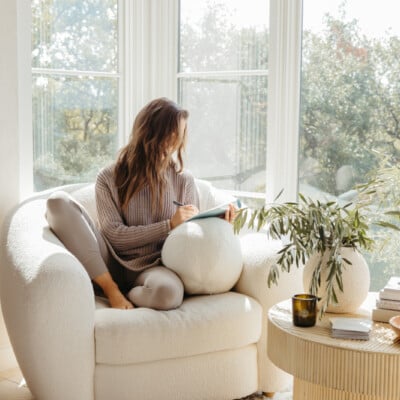The idea behind Leaf Supply is so genius you’ll wish you’d thought of it yourself: The Sydney based service offers same-day plant delivery, thoughtfully potted in chic ceramics. The result is a gift that — unlike cut flowers — keeps on giving. “We started Leaf Supply because we’re completely plant obsessed and believe strongly in their health properties and ability to make any space look more beautiful,” say founders Sophia Kaplan and Lauren Camilleri.
“We want to get more plants and confident plant owners out there into the world.”
For those of us who aren’t fortunate enough to live in Sydney, Sophia and Lauren are sharing their expertise and killer style in their new self-titled book, Leaf Supply. “It’s a guide to keeping happy house plants,” says Sophia. “We profile a ton of indoor plants and we’re also lucky enough to photograph the homes and workplaces of a bunch of other plant obsessed people. There are sections on light and temperature, water, soil and fertilizer, potting, pests and diseases, propagating, and styling. We go through everything you need to know to become a confident plant owner and then provide lots of beautiful imagery to inspire your own indoor plant gardens.”
Read on for our interview with Lauren and Sophia, and to discover their top five favorite indoor plants (and pro tips for how to style them!)
photographed by luisa brimble for leaf supply, with additional images by leaf supply

First tell us a little about your experience with plants. What makes both you experts in your field?
Sophia: We’ve all had a long standing fascination with plants. We’ve learned a huge amount from building our own collections of indoor plants (there’s nothing like making a mistake to teach you a lesson), and with every trip to the nursery and chat with the growers, our plant knowledge deepened. We want to help everyone be less intimidated by plants and understand that you don’t need a horticultural degree to grow a thriving indoor plant jungle.


Lauren: My indoor plant obsession started about eight years ago with the purchase of my first little Monstera. I was determined to keep my new plant baby alive (after some unsuccessful attempts to keep succulents in a not-so-light-filled apartment), I immediately began researching both online and in gardening books for the best care tips.
Fast forward a few years and I started to think about how I could turn my love for indoor greenery into a business, so I decided to do some Horticulture study through an online course. My knowledge of plants has grown along with my collection, it’s one big experiment and you certainly learn as much from the successes as you do from the failures. Chatting to our amazing growers and fellow plant lovers as well as connecting with the incredible plant community on social media has also been a brilliant resource for me.


What indoor plant trends are you loving right now?
Sophia: I love focusing in some areas of your home or office with a single large striking feature plant such as a Monstera or Sabre fig, and in others on creating a real jungle of plants. Having some single structural plants really draws the eye and makes a big impact. Then on the other side it’s so much fun to grow your collection and really green a space near a window with a tonne of plants. Try not to go too matchy-matchy with your pots, and having a theme (such as aged terracotta) can also be useful for beginners. Think about different leaf heights and textures, and see just how many plants you can fit into that space!

Keep scrolling for five of Lauren and Sophia’s favorite types of indoor plants, and their pro tips for each one!

Ficus alii (Sabre fig).
The overwhelming popularity of the Fiddle leaf fig means some of the more unusual and interesting figs are sometimes overlooked. With long thin leaves reminiscent of an Australian native and a tough robust nature, it’s time Ficus longifolia enjoyed its moment in the spotlight. If you’re looking for an indoor tree to create a statement in your space, look no further. It’s sure to be the next big thing, you heard it here first!

Raphidorphora tetrasperma (Mini monstera).
Often referred to as the mini monstera due to the similar shape of its foliage, they’re actually not related. This gorgeous greeny is a little harder to get your hands on but that makes it all the more appealing. While Monstera can get a little overwhelming and unruly, the Raphidorphora is a little more compact. It’s perfect for those of us in small apartments where space is at a premium.

Peperomia argyreia (Watermelon peperomia).
It’s definitely all about the leaves with the Watermelon peperomia, and it’s not at all hard to guess where the common name of these delightful plants stems. The thick, succulent leaves resembling the rind of a watermelon are a sight to behold and can grow quite large considering the smallish size of the plant overall. It can take a bit of adjustment to get the water and light requirements right with this guy but if you persevere, it’s well worth the effort.

Peacock plant (Calathea orbifolia).
Possessing some of the most striking tropical foliage out there (just ask her), this dazzling diva calls for a bit of gardening experience to keep her in check. The voluptuous, striped Calathea orbifolia is a total showoff, and worth every bit of effort to keep those gorgeous leaves happy and healthy. High humidity is really important to avoid the leaves curling and browning. Keep soil moist with a regular watering regime.

Hoya (Wax plant).
For those succulent lovers who are wanting to branch out to some indoor foliage, the Hoya provides the best of both worlds. Blessed with thick, juicy leaves these trailing beauties will bring the lushness without the effort. Also referred to as the wax plant due to its waxy foliage and stems, when it comes to tolerance, this beauty reigns supreme. She’ll even reward a bit of neglect with some banging blooms, pretty balls of teeny tiny five-pointed stars that smell as sweet as they look. As if all that wasn’t enough variegated varieties take the humble hoya to a whole new level.





My thumb has gotten a little greener recently and I have been hoping to expand my indoor plant collection. Thanks for all the suggestions of what to get next. I love the watermelon leaf plant, it will add to our current collection nicely. Thanks, and happy Monday! xAllie
http://www.theallthatglittersblog.com
There’s a great Chicago-based company that has a similar offering called Welltended. I have multiple plants from them and they’re so healthy years later.
Hi! I love succulents but these too were awesome. Thanks for sharing all these ideas!